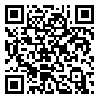Volume 13, Issue 40 (12-2021)
J Crop Breed 2021, 13(40): 122-132 |
Back to browse issues page
Download citation:
BibTeX | RIS | EndNote | Medlars | ProCite | Reference Manager | RefWorks
Send citation to:



BibTeX | RIS | EndNote | Medlars | ProCite | Reference Manager | RefWorks
Send citation to:
Babaei H R. (2021). Evaluation of Allelic Diversity in Soybean Breeding lines (Glycine max, L) using Microsatellite markers (SSR). J Crop Breed. 13(40), 122-132. doi:10.52547/jcb.13.40.122
URL: http://jcb.sanru.ac.ir/article-1-1216-en.html
URL: http://jcb.sanru.ac.ir/article-1-1216-en.html
Horticulture Crops Research Department, Khorasan Razavi Agricultural and Natural Resources Research and Education Center, AREEO, Mashhad, Iran,
Abstract: (3014 Views)
Extended Abstract
Introduction and Objective: Due to the limitation of morphologically distinguishing features that are not dependent on the environment and their Appearance forms, recognition and selection among similar lines for breeders will be associated with problems. Therefore, the use of molecular markers as a complementary method for assessing agronomic properties will be useful in identifying and selecting superior breeding lines. The aim of this study was to investigate the genetic differences of advanced soybean breeding lines to select the desired lines and eliminate duplicate lines.
Materials and Methods: in Karaj in 2013, 64 F7 generation soybean lines were planted in the greenhouse and at the appropriate time, leaf samples were taken from the seedlings of the lines and DNA samples were extracted. The resulting DNA solution was used for quantification and quality and preparation of appropriate concentration for polymerase chain reaction (PCR) by 20 microsatellite markers. After determining the genotype of the lines by polymorphic markers, Scoring genetic bands, Statistical analysis was performed using genetic data to estimate the genetic diversity indices including the number of observed and effective alleles, heterozygosity and homozygosity percentage, polymorphic information content and Shannon index. Also, for grouping the studied lines, cluster analysis by neighborhood connection method and simple similarity coefficient were used, and analysis by principal coordinates was used to check the accuracy of cluster analysis results.
Results: Based on the results of 20 microsatellite markers used to determine genetic diversity, 14 polymorphic markers showed. A total of 41 alleles were identified for gene loci, with the average number of alleles observed for each gene locus being 2.93 and the average number of effective alleles being 2.36. The range of Shannon (I) index ranged from 0.29 to 1.56 and the range of polymorphic information content (PIC) ranged from 0.78 to 0.16. Based on the measured genetic diversity indices, Sat_218 and Sat_117 markers had higher differentiation power. The cluster analysis divided the breeding lines into four groups and eight subgroups. The first three components of the principal coordinate analysis accounted for 36.6% of the total variance of the changes. The three-dimensional diagram divided the breeding lines into four groups, which was compatible relatively well with the clustering resulting from the cluster analysis.
Conclusion: In general, the results of the present study showed that the markers used had acceptable polymorphism and Sat_218 and Sat_117 markers had a higher ability to differentiate between genotypes and reveal allelic diversity. Therefore, molecular markers had the necessary efficiency to evaluate and select superior breeding lines in advanced generations.
Introduction and Objective: Due to the limitation of morphologically distinguishing features that are not dependent on the environment and their Appearance forms, recognition and selection among similar lines for breeders will be associated with problems. Therefore, the use of molecular markers as a complementary method for assessing agronomic properties will be useful in identifying and selecting superior breeding lines. The aim of this study was to investigate the genetic differences of advanced soybean breeding lines to select the desired lines and eliminate duplicate lines.
Materials and Methods: in Karaj in 2013, 64 F7 generation soybean lines were planted in the greenhouse and at the appropriate time, leaf samples were taken from the seedlings of the lines and DNA samples were extracted. The resulting DNA solution was used for quantification and quality and preparation of appropriate concentration for polymerase chain reaction (PCR) by 20 microsatellite markers. After determining the genotype of the lines by polymorphic markers, Scoring genetic bands, Statistical analysis was performed using genetic data to estimate the genetic diversity indices including the number of observed and effective alleles, heterozygosity and homozygosity percentage, polymorphic information content and Shannon index. Also, for grouping the studied lines, cluster analysis by neighborhood connection method and simple similarity coefficient were used, and analysis by principal coordinates was used to check the accuracy of cluster analysis results.
Results: Based on the results of 20 microsatellite markers used to determine genetic diversity, 14 polymorphic markers showed. A total of 41 alleles were identified for gene loci, with the average number of alleles observed for each gene locus being 2.93 and the average number of effective alleles being 2.36. The range of Shannon (I) index ranged from 0.29 to 1.56 and the range of polymorphic information content (PIC) ranged from 0.78 to 0.16. Based on the measured genetic diversity indices, Sat_218 and Sat_117 markers had higher differentiation power. The cluster analysis divided the breeding lines into four groups and eight subgroups. The first three components of the principal coordinate analysis accounted for 36.6% of the total variance of the changes. The three-dimensional diagram divided the breeding lines into four groups, which was compatible relatively well with the clustering resulting from the cluster analysis.
Conclusion: In general, the results of the present study showed that the markers used had acceptable polymorphism and Sat_218 and Sat_117 markers had a higher ability to differentiate between genotypes and reveal allelic diversity. Therefore, molecular markers had the necessary efficiency to evaluate and select superior breeding lines in advanced generations.
Keywords: Cluster analysis, number of effective alleles (Ae), Principal components analysis and Shannon index (I), Polymorphic information content (PIC)
Send email to the article author
| Rights and permissions | |
 |
This work is licensed under a Creative Commons Attribution-NonCommercial 4.0 International License. |





